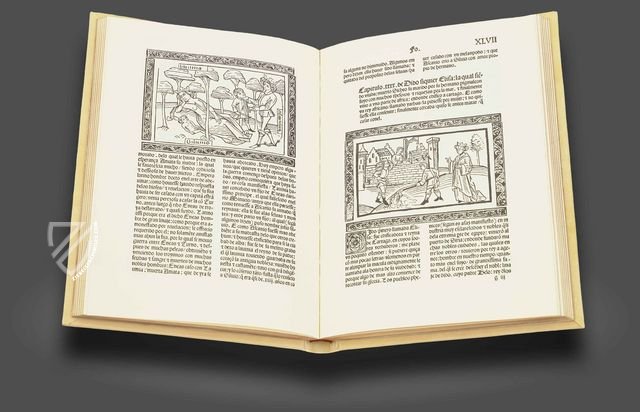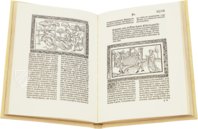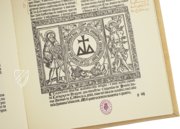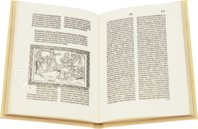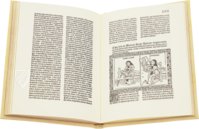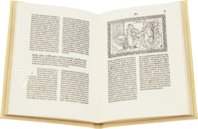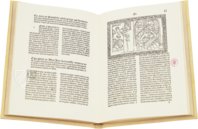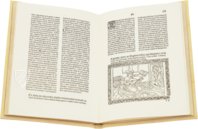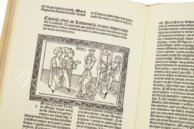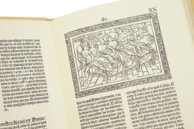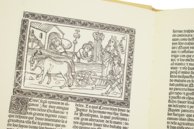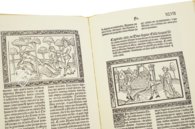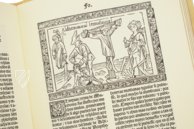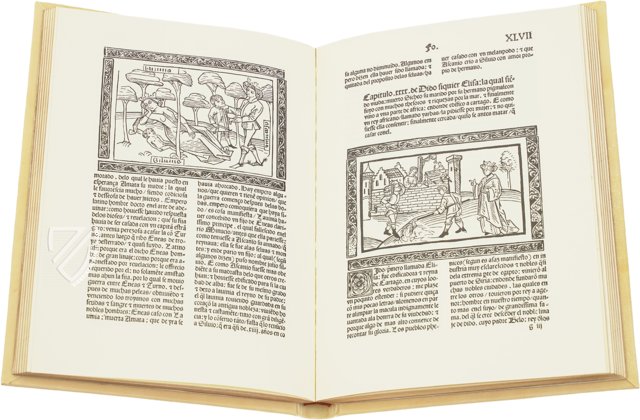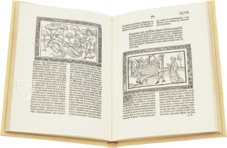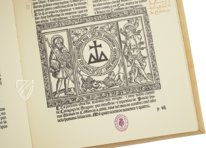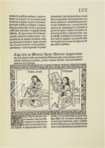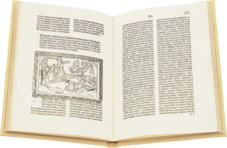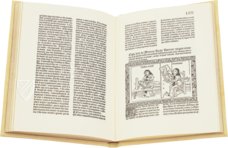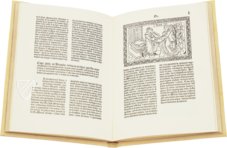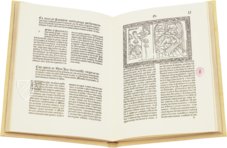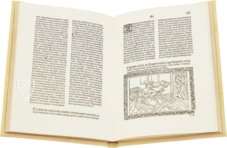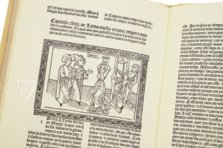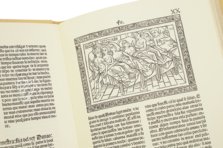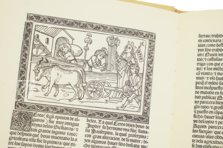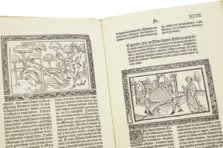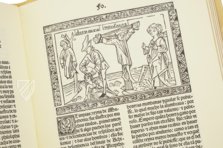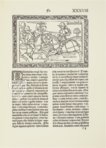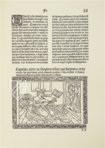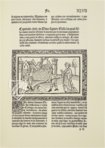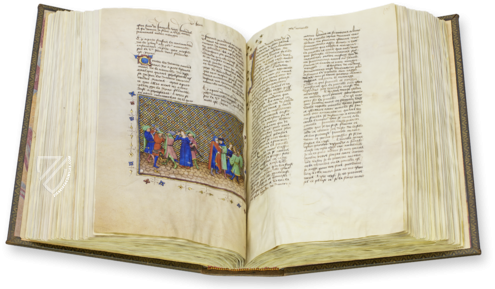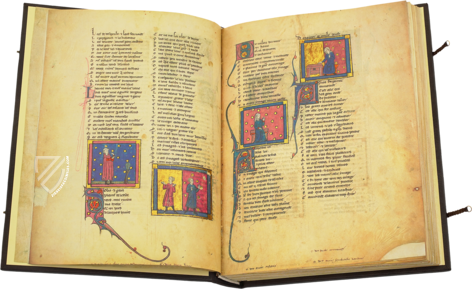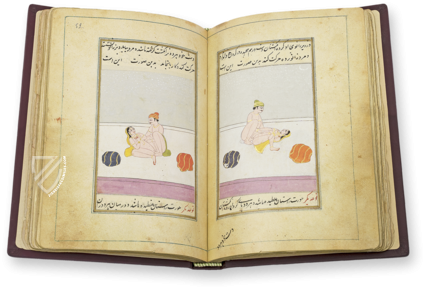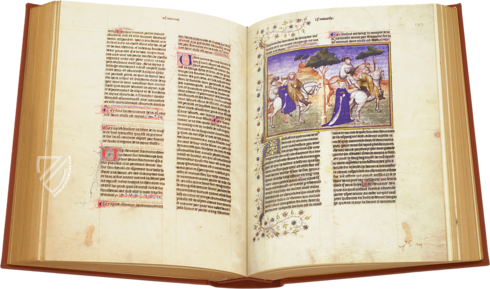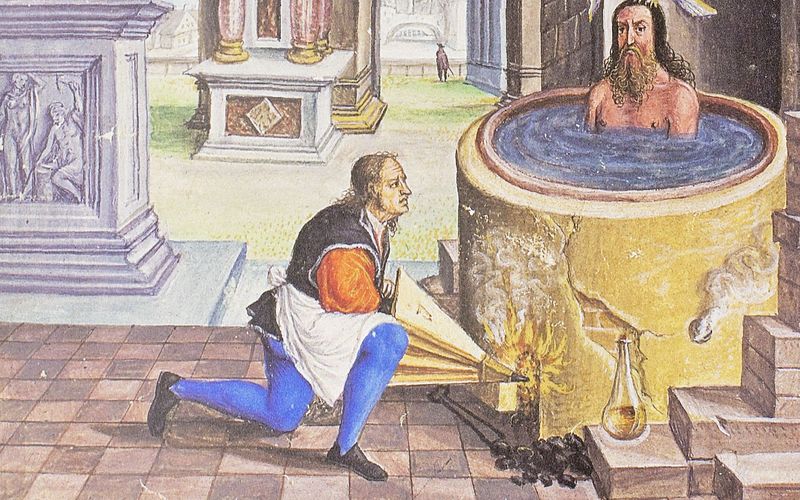On Famous Women by Giovanni Boccaccio
Between 1361 and 1362, Giovanni Boccaccio (1313–1375) wrote one of his most popular and widely circulated works: De Mulieribus Claris or On Famous Women in English. It went down in literary history as the first European book devoted exclusively to female biographies. The 106 vitae contained in this moralizing work contrast the deeds of “wicked” women with those of “virtuous” women, thereby highlighting different types of women. In creating his work, Boccaccio drew inspiration from classical authors as well as his contemporary Petrarch (1304–1374). Controversial for its misogyny, the text became a true bestseller of the late Middle Ages, spreading rapidly across the continent in dozens of manuscripts and prints and soon being translated into various languages. The first Spanish edition was published under the title Delas mujeres ilustres en romance on October 24, 1494, in Zaragoza and was produced by the German printer Paul Hurus.
On Famous Women by Boccaccio
Giovanni Boccaccio (1313–1375) was one of the most important authors of the Late Middle Ages, most famous for The Decameron. His treatise De Mulieribus Claris or On Famous Women in English, is noteworthy as the first book devoted exclusively to biographies of women in Western literature. It was composed by Boccaccio between 1361 and 1362 in the Tuscan commune of Certaldo, although he continued to revise it up to 1375. The 106 biographies contained in the work contrast the deeds of wicked women with those of virtuous women and in doing so, aimed to cover all types of women. Boccaccio dedicated the work to Andrea Acciaioli, Countess of Altavilla, and hoped that it would help to promote virtue and curtail vice. The work enjoyed great popularity and appeared in numerous translations and editions, both handwritten manuscripts and prints.
Inspirational Biographies
Boccaccio stated that he was inspired by De Viris Illustribus, a collection of famous men and women from antiquity, mythology, and the Bible written by Petrarch (1304–1374). The biographies recorded by Boccaccio range from mythological and historical women to Renaissance contemporaries. Each story begins with the subject’s name, parentage, rank or position in society, and the reason for their fame. They usually end with a lesson of a philosophical or moralizing nature. Analysis of the work indicates that he had access to plentiful classical sources including Valerius Maximus, Pliny, Livy, Ovid, Suetonius, Statius, Virgil, Lactantius, Orosius, and Justinus, Church Fathers like Saint Paul and Saint Jerome, and of course the Bible. Boccaccio’s biographies inspired characters in Le Livre de la Cité des Dames by Christine de Pizan (1364 – ca. 1430), as well as influencing other similar works as far away as England such as Defence of Good Women by Thomas Elyot (ca. 1490–1546), a text advocating the education of women, and the Legend of Good Women and The Canterbury Tales by Geoffrey Chaucer (ca. 1343–1400). This work was clearly one of the most influential of the Late Middle Ages and continues to be fascinating for modern readers.
The Spanish Incunabulum
Although already a popular text in the last golden age of manuscript production, the invention of the printing press only fueled this popularity. A printed book predating 1501 is known as an incunabulum, and this specimen falls under that category. The Spanish edition at hand titled Delas mujeres ilustres en romance was published on October 24th, 1494 by Pablo Hurus (d. 1505) in Zaragoza. It contains 75 fine engravings, mostly depicting social scenes, whose Germanic character reflects the origin of the printer, whose true name was Paul and came from Constance in southern Germany. The Gothic script in which the text is printed also reminds us that printing was still dominated by German craftsmen in this time, who had spread across Europe setting up printing houses. Today, this gorgeous incunabulum is the proud possession of the Biblioteca Nacional de España.
Codicology
- Alternative Titles
- Über berühmte Frauen von Boccaccio
Delas Mujeres Ilustres en Romance - Size / Format
- 228 pages / 29.0 × 20.5 cm
- Origin
- Spain
- Date
- October 24, 1494
- Epochs
- Style
- Genre
- Language
- Illustrations
- 75 scenic woodcuts in ornamented frames
- Content
- "De claris mulieribus" in Spanish translation
- Artist / School
- Giovanni Boccaccio (author)
Pablo Hurus (printer)
On Famous Women by Boccaccio
Dido
According to legend, primarily Virgil, the famous Phoenician city-state of Carthage was founded by Dido. Also known as Alyssa or Elissa, she was supposedly the Queen of Tyre in modern Lebanon and fled west to escape the tyranny of her brother, Pygmalion, who had her husband murdered. The city of Carthage is said to have grown and made prosperous under Dido’s wise leadership and she is shown here directing farmers in the field as the city walls are being built in the background.
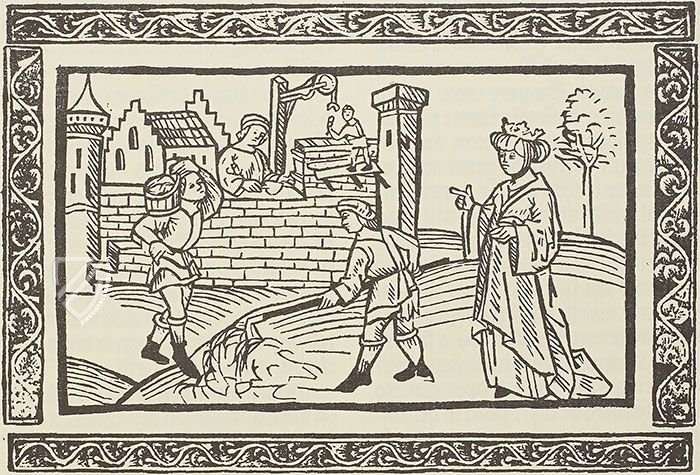
On Famous Women by Boccaccio
Penthesilea
In Greek mythology, Penthesilea was the daughter of Ares and Otrera, the Queen of the Amazons, and fought on the side of Troy in the Trojan War before being killed by Achilles. According to Boccaccio, she succeeded the queens Antiope and Orithya, was superior in strength and skill to all who came before her, and entered the war to impress Hector.
Depicted here jousting on horseback as a warrior queen, Boccaccio wrote that “through practice, Penthesilea and women like her became much more manly in arms than those born male” who had fallen to idleness and pleasure. Boccaccio is surprisingly progressive in stating that “practical experience can change natural dispositions”, suggesting gender differences are rooted in upbringing and training.
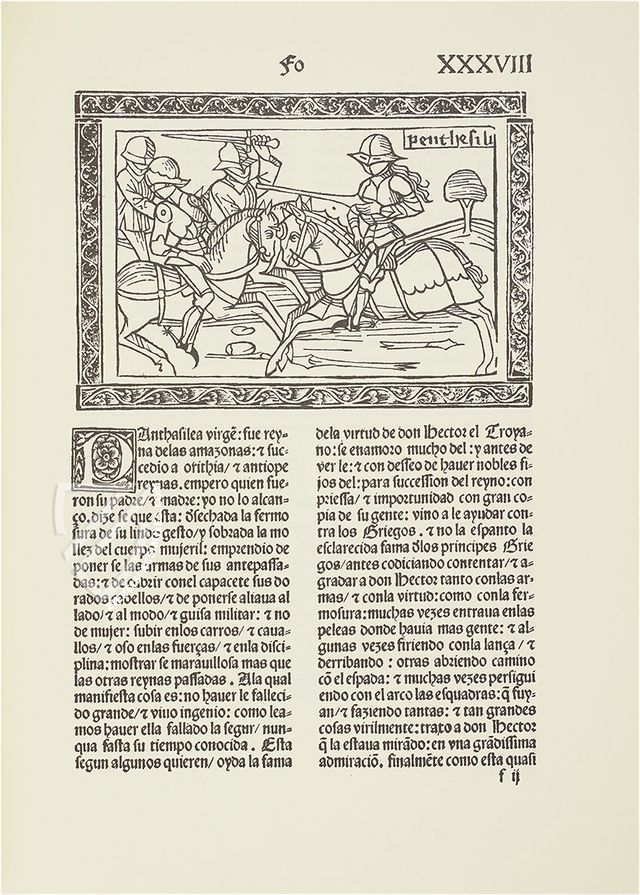
#1 On Famous Women by Boccaccio
Language: Spanish
- Treatises / Secular Books
- Apocalypses / Beatus
- Astronomy / Astrology
- Bestiaries
- Bibles / Gospels
- Chronicles / History / Law
- Geography / Maps
- Saints' Lives
- Islam / Oriental
- Judaism / Hebrew
- Single Leaf Collections
- Leonardo da Vinci
- Literature / Poetry
- Liturgical Manuscripts
- Medicine / Botany / Alchemy
- Music
- Mythology / Prophecies
- Psalters
- Other Religious Books
- Games / Hunting
- Private Devotion Books
- Other Genres
- Afghanistan
- Armenia
- Austria
- Belgium
- Belize
- Bosnia and Herzegovina
- China
- Colombia
- Costa Rica
- Croatia
- Cyprus
- Czech Republic
- Denmark
- Egypt
- El Salvador
- Ethiopia
- France
- Germany
- Greece
- Guatemala
- Honduras
- Hungary
- India
- Iran
- Iraq
- Israel
- Italy
- Japan
- Jordan
- Kazakhstan
- Kyrgyzstan
- Lebanon
- Liechtenstein
- Luxembourg
- Mexico
- Morocco
- Netherlands
- Palestine
- Panama
- Peru
- Poland
- Portugal
- Romania
- Russia
- Serbia
- Spain
- Sri Lanka
- Sweden
- Switzerland
- Syria
- Tajikistan
- Turkey
- Turkmenistan
- Ukraine
- United Kingdom
- United States
- Uzbekistan
- Vatican City
- A. Oosthoek, van Holkema & Warendorf
- Aboca Museum
- Ajuntament de Valencia
- Akademie Verlag
- Akademische Druck- u. Verlagsanstalt (ADEVA)
- Aldo Ausilio Editore - Bottega d’Erasmo
- Alecto Historical Editions
- Alkuin Verlag
- Almqvist & Wiksell
- Amilcare Pizzi
- Andreas & Andreas Verlagsbuchhandlung
- Archa 90
- Archiv Verlag
- Archivi Edizioni
- Arnold Verlag
- ARS
- Ars Magna
- ArtCodex
- AyN Ediciones
- Azimuth Editions
- Badenia Verlag
- Bärenreiter-Verlag
- Belser Verlag
- Belser Verlag / WK Wertkontor
- Benziger Verlag
- Bernardinum Wydawnictwo
- BiblioGemma
- Biblioteca Apostolica Vaticana (Vaticanstadt, Vaticanstadt)
- Bibliotheca Palatina Faksimile Verlag
- Bibliotheca Rara
- Boydell & Brewer
- Bramante Edizioni
- Bredius Genootschap
- Brepols Publishers
- British Library
- C. Weckesser
- Caixa Catalunya
- Canesi
- CAPSA, Ars Scriptoria
- Caratzas Brothers, Publishers
- Carus Verlag
- Casamassima Libri
- Centrum Cartographie Verlag GmbH
- Chavane Verlag
- Christian Brandstätter Verlag
- Circulo Cientifico
- Club Bibliófilo Versol
- Club du Livre
- CM Editores
- Collegium Graphicum
- Collezione Apocrifa Da Vinci
- Comissão Nacional para as Comemorações dos Descobrimentos Portugueses
- Coron Verlag
- Corvina
- CTHS
- D. S. Brewer
- Damon
- De Agostini/UTET
- De Nederlandsche Boekhandel
- De Schutter
- Deuschle & Stemmle
- Deutscher Verlag für Kunstwissenschaft
- DIAMM
- Droz
- E. Schreiber Graphische Kunstanstalten
- Ediciones Boreal
- Ediciones Grial
- Ediclube
- Edições Inapa
- Edilan
- Editalia
- Edition Deuschle
- Edition Georg Popp
- Edition Leipzig
- Edition Libri Illustri
- Editiones Reales Sitios S. L.
- Éditions de l'Oiseau Lyre
- Editions Medicina Rara
- Editorial Casariego
- Editorial Mintzoa
- Editrice Antenore
- Editrice Velar
- Edizioni Edison
- Egeria, S.L.
- Eikon Editores
- Electa
- Emery Walker Limited
- Enciclopèdia Catalana
- Eos-Verlag
- Ephesus Publishing
- Ernst Battenberg
- Eugrammia Press
- Extraordinary Editions
- Fackelverlag
- Facsimila Art & Edition
- Facsimile Editions Ltd.
- Facsimilia Art & Edition Ebert KG
- Faksimile Verlag
- Feuermann Verlag
- Folger Shakespeare Library
- Franco Cosimo Panini Editore
- Friedrich Wittig Verlag
- Fundación Hullera Vasco-Leonesa
- G. Braziller
- Gabriele Mazzotta Editore
- Gebr. Mann Verlag
- Gesellschaft für graphische Industrie
- Getty Research Institute
- Giovanni Domenico de Rossi
- Giunti Editore
- Graffiti
- Grafica European Center of Fine Arts
- Guido Pressler
- Guillermo Blazquez
- Gustav Kiepenheuer
- H. N. Abrams
- Harrassowitz
- Harvard University Press
- Helikon
- Hendrickson Publishers
- Henning Oppermann
- Herder Verlag
- Hes & De Graaf Publishers
- Hoepli
- Holbein-Verlag
- Houghton Library
- Hugo Schmidt Verlag
- Idion Verlag
- Il Bulino, edizioni d'arte
- ILte
- Imago
- Insel Verlag
- Insel-Verlag Anton Kippenberger
- Instituto de Estudios Altoaragoneses
- Instituto Nacional de Antropología e Historia
- Introligatornia Budnik Jerzy
- Istituto dell'Enciclopedia Italiana - Treccani
- Istituto Ellenico di Studi Bizantini e Postbizantini
- Istituto Geografico De Agostini
- Istituto Poligrafico e Zecca dello Stato
- Italarte Art Establishments
- Jan Thorbecke Verlag
- Johnson Reprint Corporation
- Josef Stocker
- Josef Stocker-Schmid
- Jugoslavija
- Karl W. Hiersemann
- Kasper Straube
- Kaydeda Ediciones
- Kindler Verlag / Coron Verlag
- Kodansha International Ltd.
- Konrad Kölbl Verlag
- Kurt Wolff Verlag
- La Liberia dello Stato
- La Linea Editrice
- La Meta Editore
- Lambert Schneider
- Landeskreditbank Baden-Württemberg
- Leo S. Olschki
- Les Incunables
- Liber Artis
- Library of Congress
- Libreria Musicale Italiana
- Lichtdruck
- Lito Immagine Editore
- Lumen Artis
- Lund Humphries
- M. Moleiro Editor
- Maison des Sciences de l'homme et de la société de Poitiers
- Manuscriptum
- Martinus Nijhoff
- Maruzen-Yushodo Co. Ltd.
- MASA
- Massada Publishers
- McGraw-Hill
- Metropolitan Museum of Art
- Militos
- Millennium Liber
- Müller & Schindler
- Nahar - Stavit
- Nahar and Steimatzky
- National Library of Wales
- Neri Pozza
- Nova Charta
- Oceanum Verlag
- Odeon
- Orbis Mediaevalis
- Orbis Pictus
- Österreichische Staatsdruckerei
- Oxford University Press
- Pageant Books
- Parzellers Buchverlag
- Patrimonio Ediciones
- Pattloch Verlag
- PIAF
- Pieper Verlag
- Plon-Nourrit et cie
- Poligrafiche Bolis
- Presses Universitaires de Strasbourg
- Prestel Verlag
- Princeton University Press
- Prisma Verlag
- Priuli & Verlucca, editori
- Pro Sport Verlag
- Propyläen Verlag
- Pytheas Books
- Quaternio Verlag Luzern
- Reales Sitios
- Recht-Verlag
- Reichert Verlag
- Reichsdruckerei
- Reprint Verlag
- Riehn & Reusch
- Roberto Vattori Editore
- Rosenkilde and Bagger
- Roxburghe Club
- Salerno Editrice
- Saltellus Press
- Sandoz
- Sarajevo Svjetlost
- Schöck ArtPrint Kft.
- Schulsinger Brothers
- Scolar Press
- Scrinium
- Scripta Maneant
- Scriptorium
- Shazar
- Siloé, arte y bibliofilia
- SISMEL - Edizioni del Galluzzo
- Sociedad Mexicana de Antropología
- Société des Bibliophiles & Iconophiles de Belgique
- Soncin Publishing
- Sorli Ediciones
- Stainer and Bell
- Studer
- Styria Verlag
- Sumptibus Pragopress
- Szegedi Tudomànyegyetem
- Taberna Libraria
- Tarshish Books
- Taschen
- Tempus Libri
- Testimonio Compañía Editorial
- Thames and Hudson
- The Clear Vue Publishing Partnership Limited
- The Facsimile Codex
- The Folio Society
- The Marquess of Normanby
- The Richard III and Yorkist History Trust
- Tip.Le.Co
- TouchArt
- TREC Publishing House
- TRI Publishing Co.
- Trident Editore
- Tuliba Collection
- Typis Regiae Officinae Polygraphicae
- Union Verlag Berlin
- Universidad de Granada
- University of California Press
- University of Chicago Press
- Urs Graf
- Vallecchi
- Van Wijnen
- VCH, Acta Humaniora
- VDI Verlag
- VEB Deutscher Verlag für Musik
- Verlag Anton Pustet / Andreas Verlag
- Verlag Bibliophile Drucke Josef Stocker
- Verlag der Münchner Drucke
- Verlag für Regionalgeschichte
- Verlag Styria
- Vicent Garcia Editores
- W. Turnowski Ltd.
- W. Turnowsky
- Waanders Printers
- Wiener Mechitharisten-Congregation (Wien, Österreich)
- Wissenschaftliche Buchgesellschaft
- Wissenschaftliche Verlagsgesellschaft
- Wydawnictwo Dolnoslaskie
- Xuntanza Editorial
- Zakład Narodowy
- Zollikofer AG

